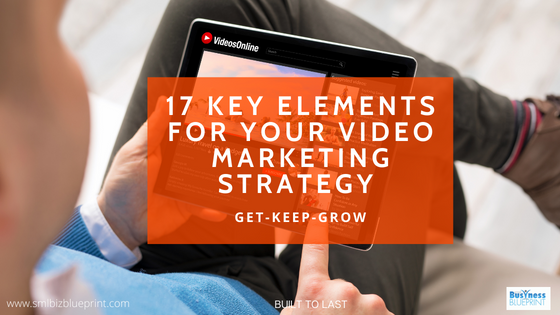Experts have dubbed video one of the most important developments in the marketing world, and it’s not going anywhere anytime soon.
Video is no longer an up-and-coming content marketing trend—it’s an integral part of many companies’ marketing plans.
Video marketing is a powerful tool for reaching and engaging your target audience.
Besides the fact that audiences love video content, there are plenty of other reasons why a solid video marketing strategy needs to be a top priority.

Here’s a list of the most important ways in which video can help your business:
Boost engagement: In this fast-paced world we live in, it keeps getting harder and harder to get people’s attention. However, video can bring a captivating and original spin to your strategy. Whether it’s to share your brand’s mission, explain how your product works, or educate your audience, you can tell a compelling and memorable story with video content. One that instantly grabs viewers’ attention and keeps them interested until it ends! Look at this example of how this brand gives a hipster and modern look to its new app with this animated explainer video:
Build credibility and trust: Video content can help you take the “business” out of your brand. Using a narrative to appeal to emotions that resonate with your intended audience, you can connect in a more intimate and personal way with them. Something that, ultimately, is going to help you humanize your brand, build credibility, and foster consumer trust. Testimonial videos are often the first choice when it comes to building trust:
Improve conversions & drives sales: This is related to the previous point – developing engaging and informative content that fosters consumer trust helps you boost conversions and increase your video strategy ROI. In fact, according to HubSpot, just including a video on a landing page can increase conversion rates by 80%. On top of that, it’s proven that people are more likely to buy a product (or service) after watching a video about it!
Help you rank higher on SERPs: One of the factors that Google uses to analyze and rank websites is on-site time – that is, the seconds/minutes that people spend browsing on a page. Well, visitors tend to stay longer on a website if there’s a video in it. Not to mention that, with YouTube being the second largest online search engine, simply having a video increases your chances of featuring high on SERPs.

17 Key Elements For Your Video Marketing Strategy
1. Set Goals
What do you want your videos to accomplish?
Where in the marketing funnel will these videos fall?
An example of a video marketing goal would be creating brand awareness.
Setting your goals and identifying the funnel stage will help you create highly effective calls to action in your video content.
2. Select Your Video Types
There are many types of videos out there, and we don’t mean where the videos will be placed–social media videos can be used for many different purposes to support your overall content strategy.
Determining the type of video that works best for your brand is an important step in your marketing strategy.
Not all videos are made the same and that’s okay–what is most important is that they are supporting your key goals.
Here are a few different types of videos and their benefits. There are plenty of other social media video ideas out there that you can try out.
Educational: These are informative and can create brand awareness for new customers. They often take a less casual and more polished tone and establish the brand as an expert. If created for current customers, then the videos could be focused on guides and tips for getting the most out of your product.
Behind-the-scenes: These give a look into company operations and employees. They sometimes serve to entertain the audience or give a virtual peek behind the curtain.
Interviews: With guest speakers, interviews are a great way of introducing your audience to a new influencer and vice versa. Handing the virtual mic over to a guest can be fun and provide a little more authenticity to your brand.
Entertaining: These include jokes, cute puppies and even pranks. They serve solely to entertain the audience but can be a great way of emphasizing your brand voice and building a sense of community among your audience.
Testimonials: In marketing, these videos look like customer highlights and help to create social proof for your brand. Videos that showcase how a customer uses your product or service and their satisfaction with it operate on a connection level: ideally, a potential customer will see themselves in that video and be persuaded to purchase.
According to one study, 48% of consumers want the video to reflect the specific product or service that they own or are interested in. If you’re spinning wheels on which type to focus on, go with this one first.
3. Create a Posting Schedule
Viewers expect regular content updates, so it’s important to think of your videos in terms of campaigns instead of posting videos at random.
Think of stories that you can tell and break them into multiple parts, posting a new update each week.
After you’ve established the content of your videos, create a publishing schedule.
Establishing and maintaining a consistent posting schedule will encourage your audience to come back for more videos. You can also space your videos out over time and use them to lead viewers up to a big product launch or exciting announcement.
Continue to implement new campaigns according to your posting schedule to keep your audience engaged in your content.
This will also help to establish your business as a leader in your industry if you post consistent, helpful video content.

4. Include Tutorials and Demos
Want to explain how your products work?
With video marketing, you can create content that demonstrates how to use them. If someone has a question about your products or services, they can view your videos before purchasing.
Tutorials and demos can ease customers’ concerns and help them feel confident in their decision to purchase a particular product or service.
This will help to convert more of your site visitors into satisfied customers.
5. Don’t Forget Calls to Action
Don’t forget to include calls to action in your videos.
If you want someone to visit your website or follow you on social media, let them know.
If someone is speaking in the video, they can easily instruct viewers to take the desired action. You can also include text in your videos that links to your website and encourages viewers to check it out for more information.
Customers might enjoy your video, but if they have no idea what to do after they watch it, you may be pouring time and money down the drain.
Adding a call to action is simple, and can spark conversions that may never have otherwise happened.
6. Optimize Videos with SEO Content
Did you know that Google indexes YouTube videos?
So when someone searches for your brand and a particular phrase, you have the opportunity to show up multiple times in the same search. To optimize your videos, you can include keywords in your video descriptions.
And you can add shortened links with calls to action that encourage people to visit your website or a landing page with a special offer.
You can also take advantage of YouTube’s tagging feature, which determines the relevance of your videos and groups similar videos together. This will help your video appear as a “related video” when viewers watch similar content.
7. Use the First Few Seconds Wisely
Attention spans online are short. In fact, the average attention span is now just 8.5 seconds.
When it comes to creating a successful video, you must bring your story to life quickly, so as to instantly gather interest as people scroll through their feeds.
In the opening seconds, you must give clarity to what your video is about and give the viewer confidence that what they’re about to watch is worth their time.
Create a hook
One of the best ways to grab attention is with a hook at the start of your video. A hook is a really quick preview of what’s coming up in the video.

8. Upload an Interesting Thumbnail
Both Facebook and YouTube enable you to upload a thumbnail to sit alongside your video. These thumbnails are a great way to grab viewers’ attention and get them excited about your video before it starts playing.
Think of thumbnails as an important first impression.
Wistia found that putting a little effort into choosing your thumbnail carefully, whether on social media or in your email marketing efforts, can actually improve your play rates.
When it comes to choosing your thumbnail, avoid a blurry, motion-filled shot. Your thumbnail should suggest that the video is high quality. Pick a different frame where your subject or environment looks crisp and clear.
Great thumbnails can begin to tell a story and show viewers what’s coming up in the video.
9. Include Closed Captions
According to an infographic by Renderforest, 85% of videos on Facebook are watched without sound. The trends are along the same lines for Instagram and Twitter.
You can further improve your ROI by adding closed captions (or subtitles). This way you’ll increase engagement, click-throughs, and leads.
Closed captioning will aid your YouTube marketing efforts too, as it:
Makes your videos accessible to a much wider audience: Over 5% of the world’s population – or 466 million people – has a disabling hearing loss.
Closed captions allow them to better enjoy your content. Moreover, you can translate your captions and have multilingual subtitles for the non-English speaking audience, further increasing the scope of your content.
It lets viewers watch videos in inopportune moments or unsuitable environments, such as while studying in a library, riding a noisy train, and so on.
10. Optimize Your Video for Search
Closed captioning serves another critical purpose: search engine optimization (SEO).
Arguably, search engine marketing (both, paid and organic) forms a big part of any digital marketing strategy. While text content such as blog posts, whitepapers, and case studies are tailor-made for achieving high rankings on Google, there is a lot you can do to get your video content up there as well.
Not to mention, YouTube is the second largest search engine after Google. Thus, optimizing your video content for the top 2 search engines can take your video marketing ROI to a whole new level.
So, how do you do that?
Here are a few pointers to get started with YouTube SEO
Choose a highly relevant title incorporating keywords
Write a comprehensive video description similar to the top-performing videos in your niche
Add all relevant tags
Add a keyword-rich transcript
And of course, add closed captions.
One thing you might have noticed is that each pointer talks about doing some text-related activity.
You see, Google’s crawlers (or spiders/bots) can’t watch or understand video content. But they can crawl textual content to understand what your video is all about.
So, doing all this will not only help achieve higher rankings on YouTube, but your video will also stand a better chance to appear in the video results on Google SERP.
Additionally, to reap the maximum SEO value from your video, host it on your own domain before uploading it to any of the social sharing platforms.
By the way, Google can now extract specific snippets of your video and display them for relevant search queries. Consequently, having keyword-rich transcriptions is a must.
11. End With a Call-to-Action (CTA)
Viewers who stick around and watch the entire video are now genuinely interested in your offerings. You might even call them “qualified leads”.
Now is your chance to guide them to perform some desired actions such as browsing your product catalogue, starting a free trial, subscribing, consuming more of your content, and so on.
Therefore, always end your videos with a call-to-action button and let your audience know exactly what they have to do next.
For example, add end-screen annotations to your YouTube videos such as a “Subscribe” button, or ask them to answer a poll.
Besides, when it specifically comes to hosting the video on your own domain, the CTA doesn’t have to be at the end of the video either.
According to a study(Open Link in new window) conducted by KISSmetrics, adding a single CTA within a video generates as much as 380% more clicks than a CTA on the sidebar of the same page. So, consider adding CTAs judiciously throughout the video.

12. Schedule & Promote the Videos
Don’t think of videos on social media as one-and-done.
One fully produced video could be uploaded to several networks over a month-long time period, depending on your social schedule.
On Twitter, you could promote it many times.
For live streams, you’ll need to promote often to ensure lots of people will join in at the right time.
One film recording session could produce multiple videos. Different clips could be used for promotion or spliced together to create new videos. Think big when you’re promoting videos.
13 Make Sure the Introduction Stands Out
A little like how we are unlikely to click on an email if we’re not inspired by the subject line, an incredible one-fifth of viewers click off a video within 10 seconds if they’re not interested in what they see.
With this in mind, the introduction of the video is vitally important and should be made inspiring, entertaining and informative, to hook the viewer and encourage them to view the whole of the video.
14 Create a Stimulating Title
By the same token, your video’s title should be stimulating and eye-catching in order to grab a viewer’s attention.
Furthermore, by using relevant keywords in a title, the video is likely to show up on the search engines when viewers search for the topic.
15. Answer Questions and Address Pain Points Directly
Now more than ever, transparency matters to consumers. People hold brands accountable and elevate business owners with a mission.
FAQ videos, tutorials, and how-to guides are a great way to answer peoples’ questions about your products in an honest and engaging way. Here are a few ways your eCommerce store can use them in your marketing:
Nest videos on product pages to explain any products the customer needs to assemble
Include how-to videos in an email to the customer once their order ships
Post on YouTube or Instagram Highlights so people can easily reference them when they need to
Sharing videos designed to solve your customers’ problems will show how much you care about their experience, which is always a good thing.

16 Distribution
Ideally, you’ll use all three distribution methods.
You know your audience and hopefully, you know how they’ll respond to your video.
Focus on the distribution method that’ll give you the biggest return.
Owned distribution is always a must, though, since you own and have complete control over these channels.
There’s the lowest barrier to entry here and they also have the most opportunity due to how many different options for distribution you have. If one form of owned doesn’t work, another surely will. And, if your goal is to capture leads, using your owned channels is especially crucial.
Posting your video on social platforms is also basically required, though the social channels you choose may differ depending on where your audience is most active.
You’ll also want to think about posting your video natively; most social platforms give native videos preference over video links from other sources.
Sometimes those insights are enough, but because you’re distributing your video in different places, you don’t want to limit your data to just one
Paid distribution is super important as well, but how much you can do will likely be limited by your cash resources.
You’ll want to think more strategically about where your highest-converting audience is and dedicate most of your budget there.
And because there are so many different forms of paid advertising even within one single channel (Facebook has numerous different types of advertisements), you want to test every channel and every type of distribution method.
Until you know which will give you the highest return, hold back on spending your entire distribution budget.
Earned distribution, like owned, is free.
You have relatively little to lose using it other than time and effort, but unlike owned and paid, the payoff can be drastically more unpredictable.
From SEO efforts that boost your search presence, to building relationships with influencers you’ve never met, you never quite know what your ROI will be — it can be enormous or it can fizzle to an end.
But don’t skip earned distribution altogether! Take a little more time to think strategically about which earned channels will help you accomplish your video goals.
17 Conversion Rate Metrics
Conversion Rate: One of the most important things you should track is your conversion rate – that is, what percentage of leads or customers you’ve made thanks to a video.
If your goal is to have your viewers complete an action like signing up for a free trial, try adding a video to your landing page to see if your conversion rate increases.
Don’t forget to include call-to-actions to help lead your audience through their purchase journey and into the role of “promoter.” Over time, you can improve based on conversion rates and the content gaps you discover.
They can be expensive, but also have high conversion rates because they often align with something the viewer is already looking for.
Conversion rate is the number of times visitors completed your desired action divided by the number of clicks on your CTA.
If your goal is to have your viewers complete an action like signing up for a free trial, try adding a video to your landing page to see if your conversion rate increases.
Interestingly, Wistia’s research also found that mid-roll CTAs appear to convert at the highest rate: Mid-roll CTAs had an average conversion rate of 16.95%, compared with a post-roll conversion rate of 10.98%.
As Wistia found, mid-roll CTAs tend to have the best conversion rates.
Now is the time to start to roll out your video marketing strategy.




